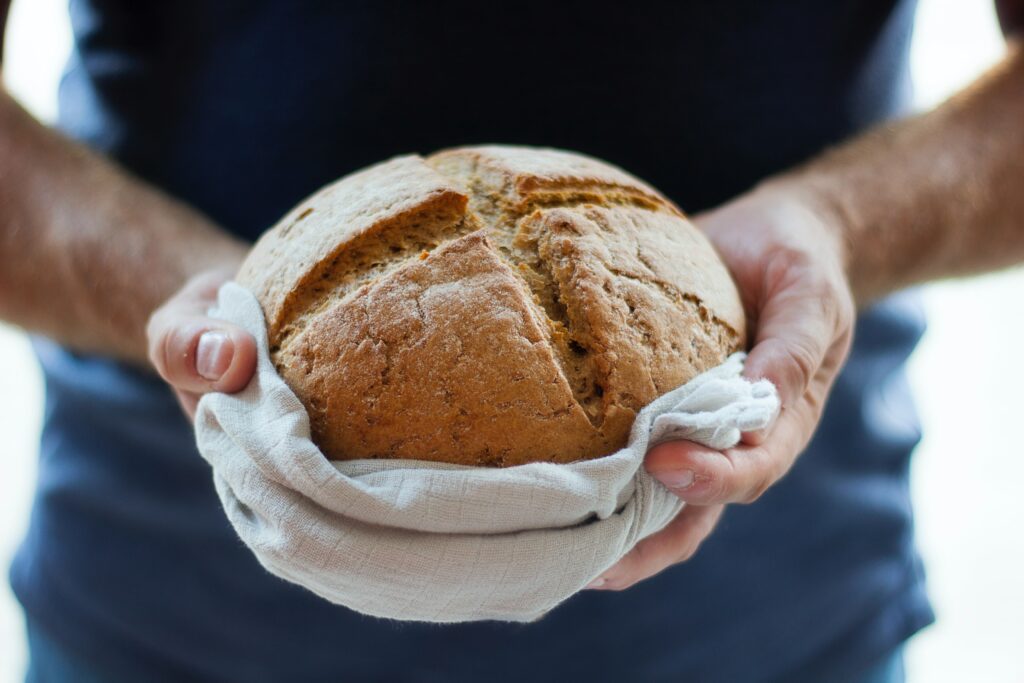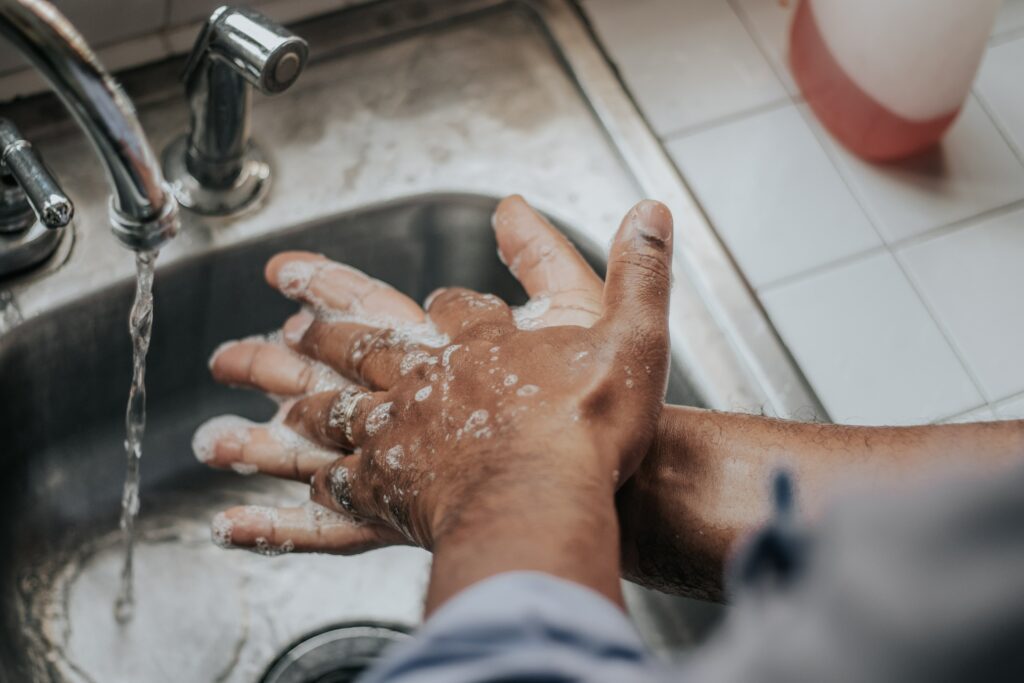
Bread of Life (part 2)
Yesterday I found myself reflecting on making sourdough bread in this time of isolation and uncertainty. Looking at the mechanics of the process and the experience leads to a different way of reflecting on life.
Making bread, especially the long slow process of sourdough, is a journey. I daresay a spiritual journey if you will let it be such. You begin with basic elements of flour and water. To make a starter, that’s the very beginning. Simply flour and water combined with time and attention. Let it work. Let it do its thing. If you rush it, the results are less than what you might hope for. If you need things to happen faster, keep it warm but not hot. Hot will kill it. If you need to slow it down, put it in the fridge. Not the freezer, just the fridge.
Isn’t that how a getting to know the heart of the Universe (which I call God) works? Basic elements like flour and water. Combine. Let it catch wild yeast in the air around it, or let any yeast trapped in with the wheat grow by giving it water. It grows and bubbles and it can double or triple in size. But, you have to feed it, and you have to remove some of it before feeding or it gets out of hand size-wise. And it might just die on you if it gets to large or out of hand.
Sometimes I think that’s a problem for big congregations (big parishes, megachurches, etc). The beginnings were active and vibrant. They understood and nourished the process. The excess was removed or allowed to go another way, while the core was fed and continued to grow and overflow and give away the excess. Isn’t that what Jesus (and/or Paul and others) seemed to want? Go out and spread the Good News to all the world.
Take that starter, feed it up, take the excess and do many things with it: bake a loaf or 2 of bread, make crumpets/waffles/tortillas, pass it on to someone else so they can feed it up and make more bread/waffles/crumpets and maybe even pass it on themselves. The resulting bread draws from the starter but the specifics are influenced by the flours that are added (whole wheat? white? eichorn? rye? barley? oats?). The product is influenced by any number of additives like powdered milk, seeds, how much salt and how much time at what temperature is used for fermenting and rising. How was it shaped and baked: in a steam oven, a dutch oven, as a boule or in loaf pans? How hot was the oven? How long did it cook?
The expression is different, but it’s all bread. And, all sourdough bread. It might be more or less sour. More or less chewy. Beautifully “decorated” by the slits made before baking. Or not. It’s all bread and it draws it life from the yeast that grew in the dough. (Don’t get me started down the road where I think about the yeast having to die before the bread is completely cooked… for another day).
It’s hard to throw away the discard when the starter is being fed or in its beginning. And, the discard can be used for other purposes. Yeah! But, if you don’t remove the discard, then your starter is going to flounder and possibly die. If you can’t let go, it (you, me) can’t grow and become healthy and active. Let it go! let it go! Rejoice that there is so much spirit or love that it has to be culled or spread around. Rejoice that there are other congregations or denominations or even religions because there is so much Love to go around. And the results are so varied and delicious.
My favorite it the simple version of the bread. Flour and water make the starter; flour and water combine and relax together; add the starter and the salt and let it work. Bake it at high heat in in a dutch oven lined with parchment paper. Crisp crust, serious bread, the taste of the sourdough coming through strongly. That doesn’t make the waffles, crumpets, sandwich loaves and buns bad or wrong. It doesn’t make it wrong when you add some yeast to help the process. They are each good in their own right.
In this time of uncertainty and social distancing, I’m having some troubles adapting. I long to be able to go to mass (not watch it on Youtube); I need the leavening and the interaction of being physically involved. I really haven’t gotten in to watching mass. It’s not a show. It’s not about seeing it “done right.” It’s about being present here and now. For me, that is very hard to do with a livestream video or recorded video. For others, this video mass is a lifesaver. I don’t feel that the church is being persecuted because of the rules about gathering close. It’s a call to look deeper and let the yeast work in whatever way it needs to do so.
Bread of Life – Sourdough

I have taken this time of isolation as a chance to revive an old practice: breadmaking. My oldest child (who is an impossible 41 years old) was in kindergarten before he knew that bread could come from the grocery store. Back then my best friend (also next door neighbor) and I had a system whereby we each made 3 loaves of bread 1/week, kept 2 and gave the other family 1. So, fresh bread on Wednesdays and Saturdays were the norm. This of course was white or multigrain, yeast bread. Right from the Tassajara Bread book.
Back in the winter, I who for years have not really eaten bread, developed a hankering for real, sour sourdough bread. Like San Francisco sourdough. I couldn’t find any in the local stores. So, just before this virus stuff got really going, I researched making your own starter, making sourdough bread, etc. I even went back to try to remember the intricacies of making just yeast bread.
Bread making is an art. There is science involved in making the art happen as well. But, I had not exercised my art in way too long so the practice was less than perfect. The first couple of attempts were less than satisfactory. Way less. The first no knead artisan loaf (yeast added, not sourdough) was less than stellar. Edible, but not really enjoyable.
I found a great video on Youtube titled 15 Mistakes Most Beginner Sourdough Makers Make. Listening (studying?) and trying out his suggestions has made all the difference in the world. Things I learned:
- it takes time — lots of time… like 10-12 hours of the process is resting, rising, fermenting
- this dough is softer and wetter that the stuff I was used to making
- despite the time, it is a gentle process which can vary from experience to experience
- I’m not in control but I must listen and watch and go with the flow
- yes you have to discard starter when it gets fed, but that doesn’t mean you have to throw it away. There are many wonderful things that can be made with sourdough discard (like crumpets)
It must be the Spirit at work. I started this before I knew anybody else would be making bread. Now I read that this seems to be a “thing” during quarantine. Must be because sometimes I can get flour, and sometimes not and sometimes those of us in town that make bread share the location where supplies can be acquired. The Spirit seems to be drawing us into this time of meditation and contemplation as we are given time for doing so. Time to let the yeast (wild caught or bought) do its job and make the bread work. Time perhaps to knead bread or stretch and fold the dough to further the mixing and give the dough shape and structure and the ability to hold a bit of a shape.
I feel Part 2 in the making. But, until then, here are a couple of Sourdough Breadmaking links for you to ponder:
And for that discard, try this: https://cms.kingarthurflour.com/recipes/sourdough-crumpets-recipe
Self-isolation a few weeks in

It seems like forever when we went out to eat at Jim&Nick’s on a Sunday evening back in early March. We sat outside on the patio. They were struggling with staffing since students at the university had gone home for spring break, but would not be returning. Restaurants were open, but cleaning like fiends. The manager stopped by to visit at the table as we at in the mild spring air. (I know it was technically winter still, but down here in the southern USA the warm spring breezes don’t wait on the Spring equinox to take up residence.)
Now, I don’t go out much. JP goes to the grocery. I do go walking and I ventured out to the local farmer’s market which is like the grocery store. But I took one of my masks, I took the hand sanitizer and I stayed what I hope was an appropriate distance from the few other customers. I ventured into the garden area at Lowes also wearing a mask.
I despise wearing a mask. It’s uncomfortable and I know they have many leaks because I wear glasses and believe me, you know when your breath escapes upwards. I’ve made 11 masks so far. We’ve done the driving to pickup and deliver for the local mask makers. I appreciate the need. I hate wearing them.
More uncomfortably, I’m leery of public places. We ventured over to Callaway Gardens where you can still stroll outside and enjoy the plants. I wouldn’t touch the handrails. I scrubbed my hands in the restroom. I stayed far from other people.
This damn virus is reinforcing my inner hermit. That inner hermit needs to be coaxed into the world to make contacts and interact. Instead, it’s being fed. That’s makes this less difficult for me than for some others. However, I’m not sure that’s the best way for me to grow.
Dan was expressing concern over how this is affecting the little guys. What will be the long term effects of social distancing on 4 year olds. They don’t understand why. At least one thinks his cousin no longer likes him since he can’t come to play or go to school. It’s true. They need to interact and be with each other. I hope we get “back to normal” sooner rather than later, but I think it’s going to be longer than any of us expect.
Carry on.
Holy Saturday, Holy Darkness
Holy Saturday — the waiting time after Jesus dies on the the cross, but before he rises much to our joy and surprise. Just what is so holy?
If you are a Christian who has walked Holy Week with the scriptures, or in other years, perhaps attended Palm Sunday, Holy [Maundy] Thursday mass, Good Friday services complete with venerating the cross, you are waiting on Easter now. Walking through Holy Week means seeing a good man, a holy man, a man without blame be put to death in a gruesome manner for doing nothing more than living his truth.
I recently had a hard drive crash. Very limited backup. For that matter, it all went south as I was hooking up a new drive to make a full backup of the one with the precious data that got damaged. It’s off with a data recovery lab now, but it could well be lost. Photographs (digital files) covering about 5 years – poof! gone. And, to make it more crushing, it happened while I was trying to make sure it couldn’t happen. I could well have knocked the drive over myself but I honestly don’t remember doing so.
I know that sounds trivial on the grand scale of things, but the impact has been so profound I find I can barely admit it to others. The embarrassment that I, who should know better, would be in a position where I could let this happen. The grief over what might be lost memories. As I wait for the data recovery folks to let me know what they can salvage, I am in darkness. Not unlike those first followers of the Way: something I thought was a given has disappeared. I don’t know if it will come back and if so, what form will it take? How much will return? What will it look like? How much will it cost?
These sorts of forced relinquishment of things I consider a part of me are little bits of how I find God working in me. Almost 20 years ago, our house burned. But, the photos came through will little damage. No people were lost. No pets died. My choice was not whether to have some parts of my life die, but how to respond to the loss. It was pretty clear that I wouldn’t die from it, that I would grieve, but all would be well.
I wonder about the Marys and the disciples. What were they going through in that time in between? It was a time of quiet. Of silence. Where was God? How could they be abandoned like that? Did Peter blame himself for denying Jesus 3 times (just as Jesus said he would)? Judas was driven to such despair he killed himself. Even when the empty tomb was discovered it seems that there was not yet any understanding of what that meant.
We are lucky. We know the next chapter. But, it seems that we must all walk through Holy Week, Good Friday, Holy Saturday and Easter over and over and over again. Leaving a few pieces behind each time. Learning once again that unless a seed falls to the ground and dies it cannot grow a new plant.
Alleluia.
Why do I still go to church?
The other night we had friends over for dinner. A bit of a disagreement or difference of opinion erupted, mostly because of my reaction to what one of our guests put forth. I fear I came across badly, but my reaction told me a lot about myself. The friend was so in awe of The Eucharist — which he proceeded to proclaim in the most magical terms of changes to physical blood and flesh. This is sort of description of The Eucharist that a) creeps me out, b) makes me angry because of what I perceive as a juvenile magic trick mentality and c) just seems so foreign to what I understand Jesus to have meant when he instituted the Eucharist at the Last Supper.
I have to do some deep searching within myself to find a better way to respond. Displaying the anger and the snark are not particularly helpful, even if they do reveal to me some strong emotions that I usually keep packed away. It’s sort of the “Why don’t you tell me how you really feel?” approach.
I’m thinking that I react so badly because others with this mentality have in the past called me heretic and tried to restructure my [malformed] conscience. I must remember that the blessing in those attempts was that I dug deep into my faith and found another dimension that was previously hidden. I searched for the meaning of the Cosmic Christ. I always come back to the reality that the Eucharistic mystery is a lot of why I am RC instead of being a part of another Christian communion. The magical approach, to me, obscures the absolute Wow factor that the Creator (God) chose to become one of us and show us that we are not alone, that we are loved beyond measure and that all of creation (bread, wine, animals, trees, rocks and volcanoes) are a part of this. I think to the words “Fruit of the field and work of human hands” — we work with God/Jesus/Spirit to create the elements that bring the reality of Love to our lives and give us a way to say “THANK YOU!”
Christmas is ongoing – day 7 now – and I am still reeling from a Christmas revelation that if we as Christians truly believe that God loves us so much that He chose to be one of us we would light the world on fire in a good way. If we accepted that it was done with the cooperation of a young woman/girl and a trusting spouse we would see that we MUST cooperate. We must trust. We can’t judge from the outside. We must love the out-of-wedlock mother, the immigrant fleeing to find safety, the smelly shepherds and the kings/wise men in our midst and on our borders. And, we say “thank you” when we receive the fruit of the vine and work of human hands.
